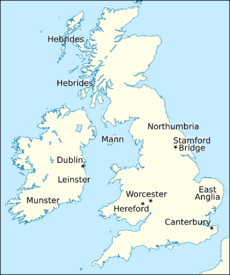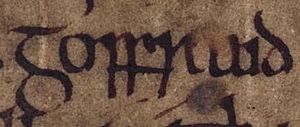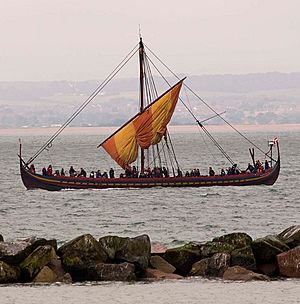Gofraid mac Amlaíb meic Ragnaill facts for kids
Quick facts for kids Gofraid mac Amlaíb meic Ragnaill |
|
|---|---|
| King of Dublin | |
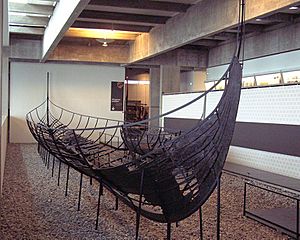
The remains of Skuldelev II may be evidence that Gofraid aided Anglo-Danish forces against the Norman King of England.
|
|
| Reign | 1072–1075 |
| Predecessor | Toirdelbach Ua Briain |
| Successor | Domnall mac Murchada |
| Died | 1075 |
| House | probably Uí Ímair |
Gofraid mac Amlaíb meic Ragnaill (died 1075) was a king of Dublin in the late 1000s. We don't know exactly who his father and grandfather were. But Gofraid was likely related to the king before him, Echmarcach mac Ragnaill, King of Dublin and the Isles.
Gofraid lived during a time when different Irish rulers wanted to control the Kingdom of Dublin. For example, in 1052, Echmarcach was forced out of Dublin by Diarmait mac Maíl na mBó, the Uí Chennselaig king of Leinster. When Diarmait died in 1072, Dublin was taken by Toirdelbach Ua Briain, the Uí Briain king of Munster. Toirdelbach either gave the Dublin kingship to Gofraid or agreed that Gofraid could rule there.
Gofraid didn't have much power on his own. He was under the control of his Uí Briain overlord, Toirdelbach. We know this from old letters between Gofraid, Toirdelbach, and Lanfranc, Archbishop of Canterbury. Gofraid's rule ended in 1075. Toirdelbach made him leave Ireland by sea, perhaps to the Kingdom of the Isles. Gofraid died that same year.
It's possible Gofraid was kicked out for helping the English and Danish people rebel against the new Norman rulers of England. Another idea is that Gofraid was secretly planning with the Uí Chennselaig against their Uí Briain overlords. After Gofraid, Domnall mac Murchada, a leader from the Uí Chennselaig family, became king of Dublin. We don't know if Domnall ruled with Toirdelbach's permission. Some people think Gofraid might be the same person as Gofraid mac Sitriuc, King of the Isles.
Contents
Who Was Gofraid?
Gofraid seems to have been a close relative of Echmarcach mac Ragnaill, King of Dublin and the Isles. We don't know much about Echmarcach's family. He might have been from the Waterford family, related to Ímar. Or he could have been from the Meic Arailt family, related to Ragnall mac Gofraid, King of the Isles.
In the 1000s and 1100s, four powerful Irish leaders tried to become "High King" of Ireland. They all wanted to control the Kingdom of Dublin first. Dublin was a Norse-Gaelic kingdom on the coast. Controlling it meant using its strong army and great riches. This was a necessary step for any Irish ruler who wanted to be High King.
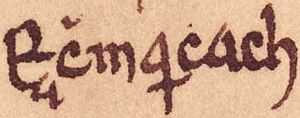
In 1052, Echmarcach was forced to leave Ireland by Diarmait mac Maíl na mBó, King of Leinster. Diarmait then became king of Dublin. For the next twenty years, Diarmait controlled Dublin, and the town was his main city. About ten years after Diarmait took Dublin, Echmarcach was attacked by Diarmait again. Diarmait's son, Murchad, raided the Isle of Man. He made a defeated "son of Ragnall" pay him money. This was probably Echmarcach himself.
Echmarcach died in Rome in 1064 or 1065. A writer from that time, Marianus Scotus, called him "King of Innarenn." This could mean "King of the Isles" or "King of the Rhinns." If it means "King of the Rhinns," it might show that Echmarcach's large sea-kingdom had shrunk to just a small area in Galloway.
When Diarmait died suddenly in 1072, Toirdelbach Ua Briain, King of Munster took control of Leinster and Dublin. An old book, the Annals of Inisfallen, says that the people of Dublin offered the kingship to Toirdelbach. This might have been propaganda from Toirdelbach's family. But it could also mean that the Dubliners preferred a distant ruler from Munster over one from nearby Leinster.
Gofraid's Time as King of Dublin
| This chart shows possible family connections between Gofraid and others. We don't know for sure if the three Ragnalls were the same person. Also shown are possible links between Gofraid and Sitriuc mac Amlaíb, and two unnamed men who died in 1087. | |||||||||||||||||||||||||||||||||||||||||||||||||||||||||||||||||||||||||||||||||||||||||||||||||||||||||||||||||||||||||||||||||||||||||||||||||||||||||||||||||||||||||||||||||||||||||||||||||||||||||||||||||||||||||||||||||||||||||||||||||||||||||||||||||||||||||||||||||||||||||||||||||||||||||||||||||||||||||||||||
|---|---|---|---|---|---|---|---|---|---|---|---|---|---|---|---|---|---|---|---|---|---|---|---|---|---|---|---|---|---|---|---|---|---|---|---|---|---|---|---|---|---|---|---|---|---|---|---|---|---|---|---|---|---|---|---|---|---|---|---|---|---|---|---|---|---|---|---|---|---|---|---|---|---|---|---|---|---|---|---|---|---|---|---|---|---|---|---|---|---|---|---|---|---|---|---|---|---|---|---|---|---|---|---|---|---|---|---|---|---|---|---|---|---|---|---|---|---|---|---|---|---|---|---|---|---|---|---|---|---|---|---|---|---|---|---|---|---|---|---|---|---|---|---|---|---|---|---|---|---|---|---|---|---|---|---|---|---|---|---|---|---|---|---|---|---|---|---|---|---|---|---|---|---|---|---|---|---|---|---|---|---|---|---|---|---|---|---|---|---|---|---|---|---|---|---|---|---|---|---|---|---|---|---|---|---|---|---|---|---|---|---|---|---|---|---|---|---|---|---|---|---|---|---|---|---|---|---|---|---|---|---|---|---|---|---|---|---|---|---|---|---|---|---|---|---|---|---|---|---|---|---|---|---|---|---|---|---|---|---|---|---|---|---|---|---|---|---|---|---|---|---|---|---|---|---|---|---|---|---|---|---|---|---|---|---|---|---|---|---|---|---|---|---|---|---|---|---|---|---|---|---|---|---|---|---|---|---|---|---|---|---|---|---|---|---|---|---|---|---|
|
|||||||||||||||||||||||||||||||||||||||||||||||||||||||||||||||||||||||||||||||||||||||||||||||||||||||||||||||||||||||||||||||||||||||||||||||||||||||||||||||||||||||||||||||||||||||||||||||||||||||||||||||||||||||||||||||||||||||||||||||||||||||||||||||||||||||||||||||||||||||||||||||||||||||||||||||||||||||||||||||
Becoming King and Trying to Stay in Power

Soon after Toirdelbach took over, the Annals of Inisfallen says that Gofraid became king of Dublin. Toirdelbach clearly agreed to this. He might have even chosen Gofraid himself. This could be because Dublin and Munster were far apart.
The Uí Briain family soon became involved in the Kingdom of the Isles after getting Dublin. In 1073, an invasion of the Isle of Man from Ireland failed. It was stopped by Fingal mac Gofraid, King of the Isles. This attack is mentioned in old books like the Annals of Loch Cé and the Annals of Ulster. The Annals of Ulster says the attack was led by Sitriuc mac Amlaíb and two grandsons of Brian Bóruma, High King of Ireland. We don't know exactly who these three attackers were or why they attacked. But it was probably connected to the Uí Briain family taking over Dublin.
Some people think Sitriuc was Gofraid's brother. It's also possible that they were both related to Echmarcach. Their family might also have included Cacht ingen Ragnaill, who was married to Donnchad mac Briain, King of Munster. Echmarcach's daughter, Mór, married Toirdelbach's son, Tadc. If the Uí Briain family was connected to Gofraid, Sitriuc, Cacht, and Echmarcach, then Sitriuc might have tried to take back his family's land in the Isles after the Uí Briain took control of Dublin.
Church Matters
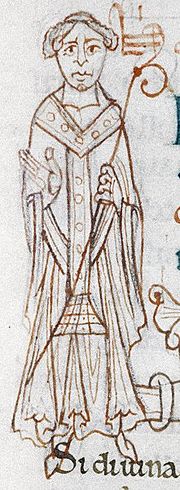
Important church leaders in Ireland usually needed the king's approval. So, when Dúnán, Bishop of Dublin died in 1074, Gofraid asked Lanfranc, Archbishop of Canterbury to make Gilla Pátraic the new bishop. Gofraid asked on behalf of Dublin's church leaders and people.
Lanfranc seemed to use Gilla Pátraic to talk to the Irish. When he sent Gilla Pátraic to Ireland, Lanfranc also sent a letter to Gofraid. In the letter, he told the king to fix bad habits among his people. These included things like divorce, remarriage, and having more than one partner. The archbishop sent a similar letter to Toirdelbach.
These Latin letters called Gofraid "the glorious King of Ireland" and Toirdelbach "the magnificent King of Ireland." This suggests that Lanfranc knew Gofraid wasn't very independent as king. He was closely tied to the power of his Uí Briain overlord. At that time, Lanfranc wanted Dublin to be a major church center, under Canterbury's authority. He wanted it to have power over the whole Irish Church.
In the eyes of church reformers, the Irish Church in the 1000s and 1100s was very old-fashioned. Lanfranc was one of these reformers. He started to reorganize the Church in the Norse-Gaelic areas of Ireland, especially Dublin. The Synod of Cashel in 1101, called by Toirdelbach's son Muirchertach, is often seen as the first reforming Irish church meeting. But there were probably earlier ones. The discussions about making Gilla Pátraic bishop might have been one of these meetings. Gofraid's support for Gilla Pátraic, and the church actions of Toirdelbach and Muirchertach, show that rulers in the Irish Sea region were open to religious changes. This was more so than other rulers in Scotland and Ireland at the time.
Being Forced Out of Ireland
Sadly for Gofraid, his time as king was short. Old books like the Annals of Innisfallen and the Annals of Ulster say that his rule and life ended in 1075. The Annals of Innisfallen says that Toirdelbach banished him overseas. It also says Gofraid died "beyond sea" after gathering a "great fleet" to come back to Ireland. So, Gofraid seems to have fled to the Isles. He died while gathering a fleet to invade Dublin.
After Gofraid left, Domnall mac Murchada became king. He was Diarmait's grandson. We don't know if Domnall ruled with the Uí Briain's permission. But he died of illness within the year. After that, Toirdelbach made his oldest son, Muirchertach, King of Dublin.
Rebellions in England
We don't know the exact reason why Gofraid was kicked out of Dublin. Domnall's quick rise to power after Gofraid's fall might mean Gofraid was involved with the Uí Chennselaig in a rebellion against the Uí Briain.
Another idea is that Gofraid might have been involved in the ongoing resistance against William I, King of England. In 1066, William had taken over England. He had removed almost all of the old English and Danish nobles. Even before Harold became king, Diarmait (Gofraid's predecessor in Dublin) was a close friend of Harold's family. After the fall of Anglo-Saxon England, Diarmait continued to support Harold's sons. He gave shelter to several of them. From Ireland, Harold's sons launched two big sea attacks on England's southwest coast. One was in 1068, and another in 1069. The later attack happened at the same time as a rebellion in northern England and a Danish invasion.
In 1075, an English rebellion against the Norman rulers was led by three earls: Roger de Breteuil, Earl of Hereford, Ralph de Gael, Earl of East Anglia, and Waltheof, Earl of Northumbria. The uprising was planned for when William was away. The rebellion also got help from Denmark. A fleet of two hundred ships, led by Knútr Sveinsson, arrived. Knútr was the brother of the Danish king.
Unfortunately for the rebels, the uprising was stopped. This was mostly thanks to Wulfstan, Bishop of Worcester. By the time Knútr's fleet reached England, the rebellion was completely crushed.
The fact that Irish people were involved in earlier rebellions against the Normans suggests that Gofraid might have been involved in the 1075 revolt. An old poem about Knútr says his fame reached as far as Ireland. This could mean there were connections between Ireland and Denmark during Toirdelbach's rule.
There might even be physical proof of Gofraid's involvement. An 11th-century longship, Skuldelev II, was found in Denmark. It was built in Dublin around 1042 and repaired around 1060 or 1075. This ship might show that Gofraid was at least giving warships to the Danes.
While Diarmait supported William's English enemies, Toirdelbach seems to have worked closely with William's government. If people from Dublin were involved in the English rebellion of 1075, this might have led to Toirdelbach kicking Gofraid out. It's interesting that Wulfstan, who helped stop the 1075 uprising, was a close friend of the new bishop, Gilla Pátraic. And Gilla Pátraic was on good terms with Toirdelbach. Whatever the reason, the record of Gofraid's "great fleet" in 1075 might actually refer to Knútr's fleet that same year. The Irish writer might have thought it was connected to the exiled Gofraid.
Gofraid mac Sitriuc
There was another person named Gofraid around the same time: Gofraid mac Sitriuc, King of the Isles. An old book, the Chronicle of Mann, says that in 1066, he gave shelter to Gofraid Crobán. This was after the Norwegians lost the Battle of Stamford Bridge. According to the book, Gofraid mac Sitriuc died in 1070. His son, Fingal, became king of the Isles after him. Not long after Fingal became king, Gofraid Crobán conquered Mann and took the kingship for himself. We don't know if he did this by defeating Fingal.
If Gofraid (the King of Dublin) is the same person as Gofraid mac Sitriuc, it could mean that Gofraid took over from Echmarcach in both Dublin and the Isles. If this is true, and they were also related to Ragnall mac Gofraid, it would mean that Ragnall's family controlled the Isles in the 1070s. If that was the case, then Sitriuc (who died in the failed invasion of Mann in 1073) was probably not from this family. He was more likely from the Meic Amlaíb, a rival family.
Also, if Gofraid and Gofraid mac Sitriuc are the same person, then Gofraid almost certainly fled to Mann after being kicked out of Dublin. And Gofraid Crobán, who seems to be from the rival Meic Amlaíb family, took the kingship of the Isles after Gofraid's death. However, there's reason to think that Gofraid and Gofraid mac Sitriuc were actually different people. And that Gofraid mac Sitriuc was related to Gofraid Crobán.
Images for kids
-
The remains of Skuldelev II may be evidence that Gofraid aided Anglo-Danish forces against the Norman King of England.


